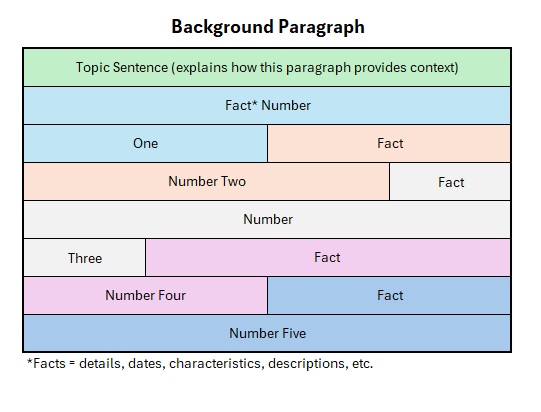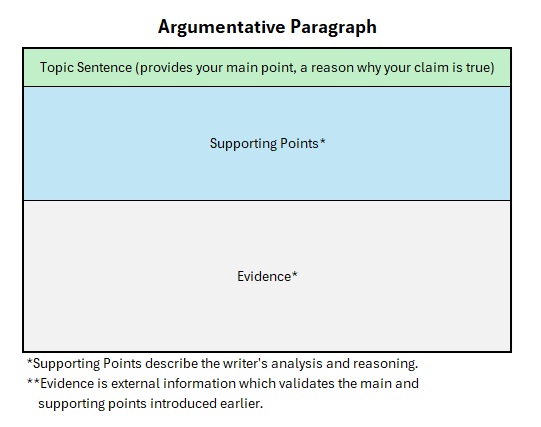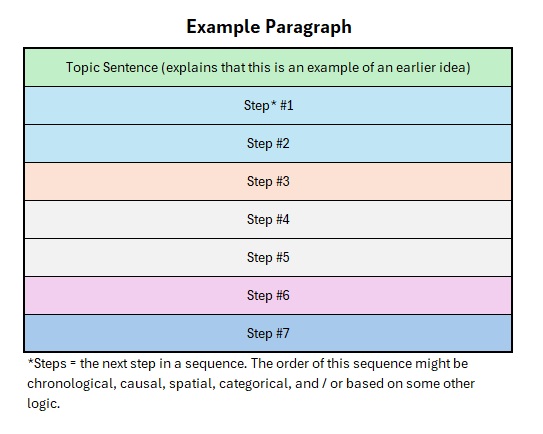
Crafting Effective Body Paragraphs
Effective paragraph structure is crucial for crafting a compelling and persuasive argument or discussion for your essay or paper.
At the heart of every body paragraph is a clear and logical progression which helps the reader move through your thoughts and ideas. Every body paragraph starts with a strong topic sentence, which acts as a guidepost for the reader. However, after the topic sentence, body paragraph purpose and structure can vary quite widely. For that reason, in this course we’ll use models for three different types of body paragraphs.
Key Insight: Although there are multiple body paragraph types, it’s important to remember that each body paragraph should discuss only one main point. Avoid long paragraphs which cover multiple main points. If you’ve written an early draft and find that your paragraph covers more than one main point, break it into two or more paragraphs, each with its own focus.
Types of Body Paragraphs
This guide covers three types of body paragraphs: background paragraphs, argumentative paragraphs, and example paragraphs. Each type of body paragraph provides a specific function in your essay or paper, and when used effectively, they work together to support your claim.
For the discussion below, we’ll review a paper based on the following details:
- Topic: social media’s impact on teenage mental health
- Thesis Statement: Social media companies should limit access by young people.
- Main Point #1: We should limit access because social media use has been directly linked to increased rates of depression and anxiety.
- Example: Here is an example of how adolescents’ engagement on social media platforms like Instagram and TikTok results in increased rates of depression and anxiety rates can increase among teenagers.
Background Paragraphs: (Otherwise Known As Beef Stew)

Background paragraphs provide necessary context information for readers to help them fully engage with your argument or discussion.
Background paragraphs often appear immediately following the introduction of your essay or paper, but they may also come later, just prior to an argumentative paragraph that introduces a particularly complicated or hard to understand main point.
Purpose: The function of a background paragraph is to provide context via information about key concepts, historical details, or critical background information, usually about the primary topic.
Paragraph Structure: Because background paragraphs tend to introduce a number of sometimes varied facts and information, they have the loosest structure of the three body paragraph types. For this reason, I sometimes call it Beef Stew, because you just need to throw in a bunch of different ingredients. Background paragraphs generally begin with an topic sentence which clearly tells the reader that this paragraph provides context, and then contains a number of sentences, each of which shares new information in no rigidly defined order.
Key Insight: Background paragraphs often appear early in an essay or paper because the writer wants to make sure the reader is aware of certain information before diving deeper into the discussion. For this reason, background paragraphs most often support the paper or essay topic, not the claim put forward in the thesis statement. The exception is when the background paragraph comes later in the paper. In those cases, the background paragraph contextual information is about the main focus or reason of the argumentative paragraph that follows the background paragraph.
Sample Background Paragraph (topic sentence is underlined):
For the example below, assume the paper or essay topic is “social media’s impact on teenage mental health.”
Before we dive into our discussion, let’s consider some background about social media’s impact. Since 2012, when smartphones became widespread, researchers have documented dramatic increases in depression and anxiety rates among adolescents, particularly in developed countries like the United States and Western Europe. Mental health experts attribute these changes to multiple factors: cyberbullying, unrealistic social comparisons triggered by filtered images, disrupted sleep patterns from excessive screen time, and the addictive design features of platforms that create dopamine-driven usage cycles. Social media affects teenagers through both direct exposure to harmful content and indirect consequences like reduced face-to-face interaction and decreased physical activity, creating a complex psychological phenomenon that researchers continue to investigate.
Argumentative Paragraphs (Make A Layer Cake)

Argumentative paragraphs are the core of your essay or paper. This is where you present the main points that support your claim, backed up by reasoning, analysis, and evidence.
Purpose: Each argumentative paragraph should highlight a single main point that supports your claim (a reason why your claim is true), provide clear supporting points that explain your main point in greater detail, followed by evidence to persuade the reader of the validity of your main and supporting points.
Paragraph Structure: Unlike background paragraphs, which tend to introduce a number of sometimes varied facts and information, argumentative paragraphs rely on a much more rigid internal structure.
- Topic Sentence: Argumentative paragraphs begin with a topic sentence that clearly introduces the main point that will be discussed in the paragraph.
- Supporting Points: The topic sentence is then followed by sentences that introduce one or more supporting points. Supporting points describe the writer’s analysis and reasoning. They provide additional details about the main point, and more fully explain why the writer believes the main point supports the thesis statement claim.
- Evidence: Finally, argumentative paragraphs generally include evidence. Evidence is external information (data, statistics, quotes, etc.) which validates the main and supporting points introduced earlier.
Key Insight: Because argumentative paragraphs are designed to support your claim, they must link back to the thesis statement, in order for readers to understand the connections between these ideas. The most effective way to do this is by repeating or “name-checking” the claim within your topic sentence. Also, a main point will usually not be convincing without supporting points. Make sure to explain your reasoning or analysis to readers, rather than only listing evidence that other sources agree with your main point.
Sample Argumentative Paragraph (topic sentence is underlined, supporting points are in brackets, evidence is inside asterisks):
For the example paragraph below, assume the paper or essay thesis statement is “Social media companies should limit access by young people.”
One reason we should limit access is because social media use has been directly linked to increased rates of depression and anxiety among teenagers. [The constant comparison with others’ curated online personas creates unrealistic expectations and damages self-esteem, while the addictive nature of these platforms disrupts healthy sleep patterns and face-to-face social interactions that are crucial for emotional development. Additionally, social media companies deliberately design features that exploit the still-developing adolescent brain, using psychological manipulation techniques to maximize engagement regardless of mental health consequences.] *Research from the American Psychological Association supports these concerns, finding that teens who spend more than three hours daily on social media platforms have double the risk of developing depression compared to those with minimal usage. Furthermore, Meta’s own internal research, revealed in congressional testimony, showed that Instagram executives knew their platform increased body dissatisfaction and suicidal thoughts among teen girls, yet continued to prioritize engagement over user wellbeing.*
Example Paragraphs (A Concrete Sequence)
 An example paragraph brings your argument or discussion to life by providing a concrete sequence that illustrates the main point of one of your argumentative paragraphs and shows it in action.
An example paragraph brings your argument or discussion to life by providing a concrete sequence that illustrates the main point of one of your argumentative paragraphs and shows it in action.
Your concrete sequence can take many forms: a case study, an anecdote, a story, a series of related events, or the steps in a process. For this reason, example paragraphs almost always follow an argumentative paragraph to further substantiate the validity of the main point highlighted in that paragraph, but can also sometimes be used to support background paragraphs – such as when a personal testimonial or story is used to more fully provide context on your topic.
Purpose: The purpose of an example paragraph is to outline the steps of a concrete sequence in order to demonstrate how a main point works or provide additional context.
Paragraph Structure: Like other body paragraphs, example paragraphs should start with a strong topic sentence, which is followed by a step-by-step sequence. The steps of the sequence should make sense, and correspond to the kind of sequence being described. For example, if the example paragraph is highlighting an interview, each subsequent step would describe the next thing that was said. If a kind of process is being described instead, then each step would correspond to a step in that process.
Key Insight: Example paragraphs differ from background paragraphs in that the steps are sequential. Whereas each sentence in a background paragraph may share a very different kind of information (one sentence might share a date, then next might share a location, etc.), each sentence in an example paragraph presents the next step in a sequence. The order of this sequence might be chronological, causal, spatial, categorical, and / or based on some other logic.
Sample Example Paragraph (topic sentence is underlined):
For the example paragraph below, notice how it supports the main point from the argumentative paragraph above: “We should limit access because social media use has been directly linked to increased rates of depression and anxiety.”
Here is an example of how adolescents’ engagement on social media platforms like Instagram and TikTok result in increased rates of depression and anxiety rates can increase among teenagers. First, a teenage user opens their preferred social media app and immediately encounters a curated feed of peers and influencers showcasing seemingly perfect lives, flawless appearances, and exciting experiences. Next, the teenager begins making automatic comparisons between these idealized posts and their own reality, which naturally includes mundane moments, physical imperfections, and everyday struggles that rarely make it onto social media. As this comparison process continues, the adolescent starts to internalize feelings of inadequacy, questioning why their life doesn’t measure up to what they see online. Over time, these repeated negative self-evaluations compound, leading to persistent feelings of sadness, worthlessness, and social isolation. This process demonstrates how social media exposure can systematically undermine teenage mental health through a predictable sequence of psychological responses.
Bringing It All Together
An effective essay or paper weaves these three types of paragraphs together seamlessly. Start with background paragraphs to provide the necessary context, followed by argumentative paragraphs where you introduce and support your main points. After certain argumentative paragraphs, use example paragraphs to illustrate your claims with concrete anecdotes.
By understanding the purpose and structure of background, argumentative, and example paragraphs, you can craft a persuasive and coherent argument or discussion. Remember, the key to a successful essay or paper is not just in presenting your ideas, but in communicating them in a clear, logical, and compelling way. Through the strategic use of these paragraph types, you’ll be able to make a persuasive case in support of your claim.